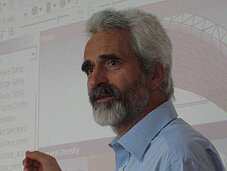
APDL Scripting in Ansys Mechanical

Learn how to increase the functionality of Ansys Mechanical with APDL command objects for special tasks. This training is offered as a 3-day course or alternatively as a self-paced eLearning course.
Duration
3 days
Prerequisites
Basic knowledge of Ansys Mechanical
Software used
Ansys Mechanical
- Access to functions beyond the Workbench GUI
- Understanding APDL scripts and working with them independently
- Impact of what Workbench imparts to solvers using APDL
- Creating own APDL macros
Description
Ansys Mechanical is a powerful tool that offers engineers a wide range of functions and a largely automatic selection of efficient and proven model settings. With APDL command objects (Ansys Parametric Design Language), you can extend your Ansys Mechanical setup to realize your own ideas of model design. You can define complex boundary conditions and perform evaluations exactly as you like.
In this training, you will gain a deeper insight into the interaction between Ansys Mechanical and the Mechanical APDL Solver (MAPDL). This allows you to examine and modify the model structure generated by Mechanical. You will also learn how to use APDL as a programming language, for example to implement automated evaluations.
We will use examples from the field of structural mechanics, but the methods are independent of this and can be transferred to other physical domains. This training is suitable for users who already have a command of the basic functionalities of Ansys Mechanical and want to gain access to all the possibilities of the MAPDL solver. Take this opportunity to expand your skills!
Get a first impression and test the first eLearning module of this training course without any obligation. No costs, no notice period.
Detailed agenda for this 3-day training
Day 1
01 How Mechanical and the MAPDL Solver work together
- Nomenclature
- Examples of intervention options by the user
- Model structure: Introduction of hydrostatic fluid elements into an analysis
- Snippet building blocks in typical simulations
- The "interfacing" between Ansys Mechanical and the MAPDL solver
- Influence mechanical model definitions via APDL
02 MAPDL Editor: the APDL Solver has its own user interface
- Starting the MAPDL GUI
- User interface and basic menu functions
- PREP7/SOLU/Post – the operating modes of the Solver
- Help to self-help: Use of Ansys Online Help
- Demo: Understanding an input stream – three-hinged arch verification manual VM4
- Elements in MAPDL: a conglomeration of ID references
03 Understanding a Mechanical ds.dat input file
- Demo example: The three-hinged arch as a mechanical model
- Comparison of VM4 input and Mechanical ds.dat input stream
- What are the differences?
- Switching element types with a Command-Snippet
04 Optimization of model formulation: targeted modification of element properties
- Element selection with Ansys Workbench and Ansys Mechanical
- Workshop: flange connection
- Element formulation of solid elements
- Surface effect and contact elements
Day 2
05 Selections as prerequisites for automated internal load determination
- Selection status of nodes and elements
- Selection functions with GUI or APDL commands
- Evaluation and presentation of results
- Workshop Flange example: Selecting the bolt geometry
- Demo: Determining reaction forces via FSUM
06 Automation: introduction to programming with APDL
- Query scalar parameters, setup, and results from the database
- Demo: flange example
- Set summation point automatically
- Determine reaction loads
- Workshop: flange example with many bolts
- Determine element attributes and use them for selection: manually and using a loop
07 Defining loads and boundary conditions via scripts
- Restraints and forces at nodes
- Understanding coordinate systems and nodal coordinate systems
- Pressures and forces as surface loads
- body loads
- Workshop: Rotating metal drum in a fixed frame of reference
- Define rotating gravitational vector
- Show inhomogeneous area loading of a bulk material
08 Controlling solution and result outputs
- Analysis type, load steps, substeps
- Step control - load control
- Further solution settings as well as output control
- Bolt preload: a very special constraint
- Workshop: Parameterization of bolt preload with APDL
Day 3
09 Working efficiently with large data volumes
- Using strings, vectors and matrices
- Dimension, describe and read field types
- Output and reading of vectors and matrices using ASCII files
- Workshop: Writing node results of a flange model to an ASCII file
- Outlook: vector operations
10 Custom boundary conditions with table parameters
- Ramped load-time description or using a table
- Model property description with table parameters
- Dimension, describe, read table parameters
- Automatic internal interpolation with table parameters and primary variables
- Workshop: Rotating metal drum in a fixed frame of reference
- Define rotating gravity vector with 1D table
- Show inhomogeneous area load of a bulk material with a 2D table
11 More details on selected topics
- Review or more details on selected topics
- Optional examples
- Discussion of questions and ideas brought up during the course
12 Outlook - Infinite Automation and Customization Possibilities
- Overview Automation and customization options with Ansys Mechanical
- Demo using Python Objects: three-hinged arch with Mechanical look and feel user input
- Demo using pyAnsys ecosystem: incorporating three-hinged arch problem into Python workflow using pyMAPDL library
Your Trainers

Klaus Graf

Dr. rer. nat. Martin Hanke

Florian Hollaus

Ulf Friederichs

Dr. Ing. Benoit Fontenier
Placement in the CADFEM Learning Pathway
Participant data
Additional information
Commentary
Get a first impression and test the first eLearning module of this training course without any obligation. No costs, no notice period.
Whether eLearning, classroom courses, live online training or customized workshops - together we identify the best option for you.
What CADFEM customers are saying
Do you have questions on the training or the eLearning?
If you book through your university, you will receive a 50% discount on the stated fee on training courses and eLearning courses.
For more information on the validity and how booking with the code ACADEMIC50 works, please visit our page on training for academic users.
Straight after you sign up, an automatic confirmation of receipt will be sent to the email addresses you provided. Once you have successfully verified the data you provided, you will receive your personalized sign-up confirmation, containing further information on course fees, the billing address, etc., by email within two to three working days.
As soon as the minimum number of attendees has been reached, you will receive a final training confirmation containing further information. If you have booked an on-site training, we recommend that you wait until you have received this final confirmation before booking your travel and accommodation.
If the minimum number of attendees is not reached, we reserve the right to cancel the training seven days before it is due to start at the latest. We are happy to inform you on changing your booking to an alternative date. Please note that we accept no liability for hotel or travel bookings that attendees have already made.
Usually the training courses start at 9:00 am and end at 5:00 pm of the respective local time. The actual course times will be stated in the booking confirmation. Please note that, depending on the training host, there may be a possible time shift between your and the provider's local time. Therefore all local times are provided with the valid time shift to Greenwich Mean Time (GMT).
To get a clear impression of our online learning format, we offer you a trial allowing you access to the starting module of an eLearning course of your choice. No costs, no cancellation period or anything similar. Moreover, with this free test access you can check all the technical requirements for a smooth learning process. You can easily request the free module from any eLearning course.
Each online course day comprises four eLearning modules. You should ideally allow 90 to 120 minutes of uninterrupted learning time for each module. This will allow you to acquire the knowledge provided by a module and to consolidate it through quiz questions and Ansys exercises. By dividing each module into micro learning units, you can also make good use of smaller time windows, such as on your commute.
Prerequisite for the use of the eLearning courses is the use of a personalized access to the CADFEM learning platform. When purchasing an eLearning course, access to the learning platform is 365 days. As a subscription user, access to the learning platform starts and ends with the start and end of the flat rate. With the start of a further learning product (Learning Subscription, training, eLearning), access to your content is extended by 365 days.





